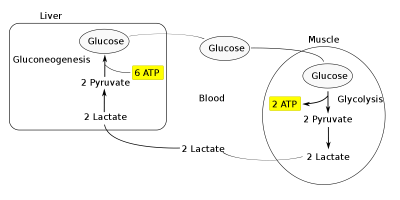
The Cori cycle (also known as the Lactic acid cycle), named after its discoverers, Carl Ferdinand Cori and Gerty Cori, refers to the metabolic pathway in which lactate produced by anaerobic glycolysis in the muscles moves to the liver and is converted to glucose, which then returns to the muscles and is metabolized back to lactate.
The cycle’s importance is based on preventing lactic acidosis during anaerobic conditions in the muscle. However, normally, before this happens, the lactic acid is moved out of the muscles and into the liver.
Additionally, this cycle is important in ATP production, an energy source, during muscle exertion. The end of muscle exertion allows the Cori cycle to function more effectively. This repays the oxygen debt so both the electron transport chain and citric acid cycle can produce energy at optimum effectiveness. This acid attributes to the sore feeling in muscles after extensive exercising.
The Cori cycle is a much more important source of substrate for gluconeogenesis than food. The contribution of Cori cycle lactate to overall glucose production increases with fasting duration before plateauing. Specifically, after 12, 20, and 40 hours of fasting by human volunteers, gluconeogenesis accounts for 41%, 71%, and 92% of glucose production, but the contribution of Cori cycle lactate to gluconeogenesis is 18%, 35%, and 36%, respectively. The remaining glucose production comes from protein breakdown, muscle glycogen, and glycerol from lipolysis.
The drug metformin can cause lactic acidosis in patients with kidney failure because metformin inhibits the hepatic gluconeogenesis of the Cori cycle, particularly the mitochondrial respiratory chain complex 1. The buildup of lactate and its substrates for lactate production, pyruvate and alanine, lead to excess lactate. Normally, the excess lactate would be cleared by the kidneys, but in patients with kidney failure, the kidneys cannot handle the excess lactic acid.
Picture Credit : Google



